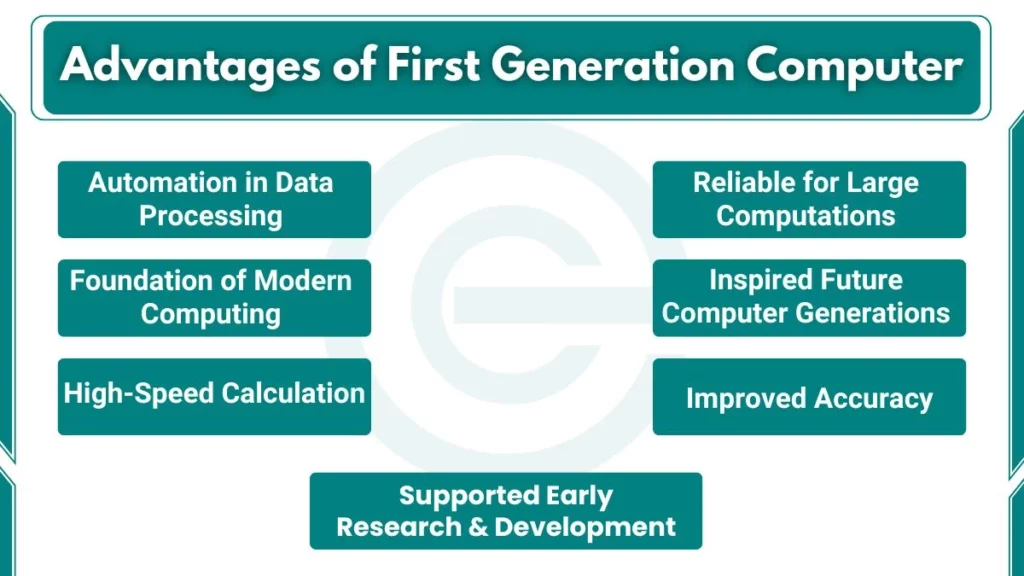Advantages of first generation computer include introduced automation, improved calculation speed, and increased accuracy in data processing. These early machines laid the foundation for modern computers and inspired future technological advancements.

Advantages of First Generation Computer
The following are benefits of first generation computer:
1. Foundation of Modern Computing
The biggest advantage of first-generation computers is that they laid the foundation of modern computing.
Before them, calculations were done by hand or using mechanical devices. These computers introduced the world to electronic data processing.
They proved that machines could think logically and follow a set of instructions. Every modern computer from desktops to smartphones, is based on the same principle they introduced. These principles are input, process, and output.
2. Automation in Data Processing
The first generation of computers introduced automation in the computing world. Once a program was entered, the machine could execute a sequence of operations automatically.
This was a big change from earlier manual systems where humans had to control every step. Automation saved time and reduced human involvement in calculations. This concept of “automated data processing” became the foundation for later software and operating systems.
Today, automation is everywhere from online payments to self-driving cars and it all began with these early computers.
3. Pioneering Use of Electronic Components
Before the first generation, all computing devices were mechanical. But first-generation computers used vacuum tubes, electronic switches that could turn on and off quickly.
This shift from mechanical to electronic technology was a big step forward. Vacuum tubes allowed faster data processing and created the path for future advancements.
It also showed that electronic signals could perform calculations better than gears and levers. That discovery became the base for modern electronics and digital circuits.
4. High-Speed Calculation (for Their Time)
In the 1940s, manual and mechanical calculations were extremely slow. The first generation of computers changed that.
They could perform thousands of calculations per second. This speed was unbelievable at that time. For example, ENIAC could perform complex mathematical operations much faster than any human or mechanical device.
This made them very useful in fields like military research, engineering, and scientific experiments, where quick and accurate results were needed.
5. Reliable for Large Computations
These computers were designed for long and complex computations. Unlike humans, they did not get tired or make mistakes after long hours of work.
They could handle huge data volumes and perform repetitive tasks accurately. This reliability made them important in projects that required continuous data processing, such as census calculations or large scientific simulations.
Although they sometimes failed due to overheating. Their computational accuracy was a great advantage for their time.
6. Encouraged Development of Machine Language
The first-generation computers worked using machine language, which is made up of binary digits (0s and 1s).
Although it was difficult for programmers, it helped them understand how computers think and operate. This early learning paved the way for the development of assembly language and high-level programming languages later on.
By experimenting with machine code, computer scientists learned how to communicate with machines.
7. Inspired Future Computer Generations
Every new technology learns from the old one. The first generation computers inspired engineers to design faster and smaller machines.
Their disadvantages such as heat production and high power consumption, motivated scientists to search for better solutions. This led to the invention of transistors in the second generation of computers.
Without the knowledge gained from the first generation, this progress would not have been possible. In short, they acted as the stepping stone for all later generations of computers.
8. Improved Accuracy
Before computers, manual calculations often contained human errors. The first generation of computers reduced these errors by performing calculations automatically.
They followed programmed instructions strictly, which meant results were more accurate and consistent. This improvement helped in areas like engineering, physics, and defense. Where even small mistakes could cause big problems.
9. Supported Early Research and Development
The first generation computers played a big role in early scientific research. They were used to solve complex mathematical problems, design weapons during World War II, and run experiments that required heavy computation.
Their power and speed supported many innovations in physics, cryptography, and communication systems.
These research efforts laid the groundwork for modern science, space exploration, and computer technology.
10. Introduced the Concept of Stored Programs
One of the most revolutionary ideas that came from this era was the stored program concept. In early computers, programs had to be entered manually each time. Later, first-generation systems introduced a new idea of storing both data and instructions in memory.
This allowed computers to perform multiple tasks automatically without manual re-entry. The concept of stored programs became the foundation of computer architecture, and it is still used in every computer today.
